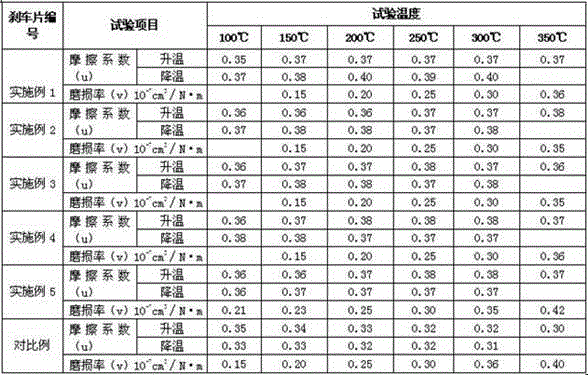Micro-copper-formulated ceramic brake pad
A brake pad and formula technology, applied in the field of ceramic brake pads, can solve the problems of excessive copper and other heavy metal substances, easy decay of the friction coefficient, cracks on the friction surface, etc., achieving long service life, no brake squeal, friction The effect of coefficient stabilization
- Summary
- Abstract
- Description
- Claims
- Application Information
AI Technical Summary
Problems solved by technology
Method used
Image
Examples
Embodiment 1
[0031]Example 1: 8 parts of aramid pulp (100 grams each, the same below), 8 parts of carbon fiber, 2 parts of magnesium hydroxide, 0.5 parts of brass cotton, 5 parts of brown corundum, 6 parts of antimony sulfide, 15 parts of ceramic fiber, 3.5 parts of superfine iron oxide powder, 8 parts of calcium sulfate whisker, 9 parts of potassium titanate, 10 parts of barite, 5.5 parts of flake graphite, 6 parts of calcined petroleum coke, 1.5 parts of nano hollow floating beads , 3 parts of flake aluminum powder, 2 parts of nitrile rubber powder, 5 parts of cashew nut shell oil modified phenolic resin, 2 parts of zircon, 3 parts of boron nitride, 0.3 part of zinc oxide, 3 parts of benzoxazine resin In the high-speed disperser, stir it into a uniformly dispersed powder, then take out the friction material composition, put it into a forming mold, press it, and then compound it with a steel back, put it into a flat vulcanizer at a high temperature of 270 ° C, and a pressure of 18 MPa. 15...
Embodiment 2
[0032] Example 2: 9 parts of aramid pulp, 9.2 parts of carbon fiber, 2.5 parts of magnesium hydroxide, 0.5 parts of brass cotton, 5 parts of brown corundum, 6.5 parts of antimony sulfide, 15.7 parts of ceramic fiber, and ultrafine iron oxide 3.5 parts of powder, 8.5 parts of calcium sulfate whiskers, 9.7 parts of potassium titanate, 10.5 parts of barite, 5.5 parts of flake graphite, 6.5 parts of calcined petroleum coke, 1.5 parts of nano hollow floating beads, 3.5 parts of flake aluminum powder, nitrile Pour 2.5 parts of rubber powder, 5.5 parts of cashew nut shell oil modified phenolic resin, 2.25 parts of zircon, 3.5 parts of boron nitride, 0.35 parts of zinc oxide, and 3.5 parts of benzoxazine resin into the high-speed disperser, and stir to form a uniform dispersion Take out the friction material composition after it is in powder form, put it into a forming mold and press it into shape, then compound it with a steel back, put it into a flat vulcanizer at a high temperature ...
Embodiment 3
[0033] Example 3: By weight, 10 parts of aramid pulp, 10.5 parts of carbon fiber, 3 parts of magnesium hydroxide, 0.75 parts of brass cotton, 5.5 parts of brown corundum, 7 parts of antimony sulfide, 16.5 parts of ceramic fiber, and ultrafine iron oxide 4.3 parts of powder, 9 parts of calcium sulfate whiskers, 10.5 parts of potassium titanate, 11 parts of barite, 6.2 parts of flake graphite, 7 parts of calcined petroleum coke, 1.75 parts of nano hollow floating beads, 4 parts of flake aluminum powder, nitrile Pour 3 parts of rubber powder, 6 parts of cashew nut shell oil modified phenolic resin, 2.5 parts of zircon, 4 parts of boron nitride, 0.4 part of zinc oxide, and 4 parts of benzoxazine resin into the high-speed disperser, and stir to form a uniform dispersion Take out the friction material composition after it is in powder form, put it into a forming mold and press it into shape, then compound it with a steel back, put it into a flat vulcanizer at a high temperature of 27...
PUM
| Property | Measurement | Unit |
|---|---|---|
| friction coefficient | aaaaa | aaaaa |
| friction coefficient | aaaaa | aaaaa |
Abstract
Description
Claims
Application Information
 Login to View More
Login to View More - R&D
- Intellectual Property
- Life Sciences
- Materials
- Tech Scout
- Unparalleled Data Quality
- Higher Quality Content
- 60% Fewer Hallucinations
Browse by: Latest US Patents, China's latest patents, Technical Efficacy Thesaurus, Application Domain, Technology Topic, Popular Technical Reports.
© 2025 PatSnap. All rights reserved.Legal|Privacy policy|Modern Slavery Act Transparency Statement|Sitemap|About US| Contact US: help@patsnap.com

